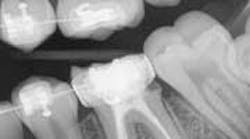Why implementing a system of checks and balances in orthodontics is important
Fig. 1
As far as the patient and parent were concerned, all was well. The chief goal was to get a cleaning and examination. Some may claim that it is not the attending orthodontist’s responsibility to diagnose caries, but if something was amiss, then discussion and recommendation needed to be initiated to address any concerns. For the previous attending dentist, updated exam and radiographs were definitely past due prior to giving a verbal recommendation to commence with orthodontics. For the current attending dentist, informing the patient’s mother of the severity of disease and questionable restorability of tooth No. 19 instigated frustration and questions.
ALSO BY DR. STACEY SIMMONS |Orthodontic options for the ectopic eruption of a maxillary first molar
It was apparent that a system of checks and balances was not in place, which put everyone in a precarious position. As a general dentist, communication is vital when referring patients to specialists; the toss-back collaboration is just as important.
ALSO BY DR. STACEY SIMMONS |The benefits of removing orthodontic hardware during recare appointments
Two main points that ran through my mind when I did this patient’s examination were:
- Oral hygiene was a definite issue.
- Caries was clearly obvious around the fillings that were breaking down on Nos. 3 and 19. Its existence was definitely there prior to the placement of the orthodontic bands and wires. (It had only been four months!)
Oral hygiene
Despite the advances in technology, the Achilles heel in orthodontics is patient home-care compliance. Inadequate pretreatment oral hygiene and poor oral hygiene during orthodontic therapy are associated with a greater incidence and severity of white spot lesions (WSL). (1) Recurrent caries and interproximal caries are also very common. Establishing proper oral hygiene and effective home-care routines are, therefore, vital. Eppright et al. suggested that factors affecting a patient’s compliance include: a strong internal locus of control possessed by the patient, a strong interpersonal relationship between orthodontist and patient, documentation of improvement in oral hygiene after detailed instruction, successful school performance on the part of the patient, and positive parental attitudes toward treatment. (1)
In this case, the patient was past due for her cleaning. Her current state of home care was inadequate, and the amount of inflammation, plaque, and tartar set the stage for a disappointing (and expensive) postorthodontic experience. The status quo needed to change.
Presence of caries
Commencing with patient care — whether restorative or orthodontics — is always in the patient’s best interest, especially when hurdles (i.e., time, finances, etc.) are overcome that prevent care in the first place.
The aforementioned situation is a perfect example of why communication among colleagues should always be initiated and any recommended treatment completed prior to elective orthodontic care. Assuming or taking a patient’s word that something is done may not be good enough. This author will submit that written communication, verification, and documentation of any exchange between all involved parties will offer resources for future questions or legal complications that may arise. Simply put — a system of checks and balances is crucial.
For the case presented here, thorough and detailed oral hygiene instructions were given by the hygienist, an electric toothbrush was suggested, and a four-month prophylactic rotation was recommended. Treatment entailed removing the bands and addressing the caries. Upon removal of the band on No. 19, there was very little tooth structure left. A new buildup with a stainless steel crown was placed. Due to the amount of leaking and lack of tooth structure, the patient’s mother was informed that the prognosis for the tooth was guarded.
As health-care providers, some things are out of our control — i.e., variances with medicine, patient compliance, and unexpected outcomes. However, it is in both our and our patients’ best interests to put in a system of checks and balances in place for all aspects of care that allows us the ability to oversee and regulate.
Reference
1. Eppright M, Shroff B, Best A, Barcoma E, Lindaur S. Influence of active reminders on oral hygiene compliance in orthodontic patients. Angle Orthodontist. 1984;84(2).







